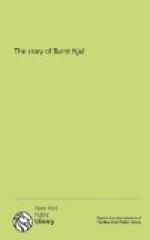We have hitherto treated only of the passages and recesses of the side aisles. The whole of the nave within the wainscot, between the inner round pillars, was filled by the hall properly so called. It had long hearths for fires in the middle, with louvres above to let out the smoke. On either side nearest to the wainscot, and in some cases touching it, was a row of benches; in each of these was a high seat, if the hall was that of a great man, that on the south side being the owner’s seat. Before these seats were tables, boards, which, however, do not seem, any more than our early Middle Age tables, to have been always kept standing, but were brought in with, and cleared away after, each meal. On ordinary occasions, one row of benches on each side sufficed; but when there was a great feast, or a sudden rush of unbidden guests, as when Flosi paid his visit to Tongue to take down Asgrim’s pride, a lower kind of seats, or stools were brought in, on which the men of lowest rank sat, and which were on the outside of the tables, nearest to the fire. At the end of the hall, over against the door, was a raised platform or dais, on which also was sometimes a high seat and benches. It was where the women eat at weddings, as we see from the account of Hallgerda’s wedding, in our Saga, and from many other passages.
In later times the seat of honour was shifted from the upper bench to the dais; and this seems to have been the case occasionally with kings and earls In Njal’s time, if we may judge from the passage in the Saga, where Hildigunna fits up a high seat on the dais for Flosi, which he spurns from under him with the words, that he was “neither king nor earl,” meaning that he was a simple man, and would have nothing to do with any of those new-fashions. It was to the dais that Asgrim betook himself when Flosi paid him his visit, and unless Asgrim’s hall was much smaller than we have any reason to suppose would be the case in the dwelling of so great a chief, Flosi must have eaten his meal not far from the dais, in order to allow of Asgrim’s getting near enough to aim a blow at him with a pole-axe from the rail at the edge of the platform. On high days and feast days, part of the hall was hung with tapestry, often of great worth and beauty, and over the hangings all along the wainscot, were carvings such as those which ... our Saga tells us Thorkel Foulmouth had carved on the stool before his high seat and over his shut bed, in memory of those deeds of “derring do” which he had performed in foreign lands.




